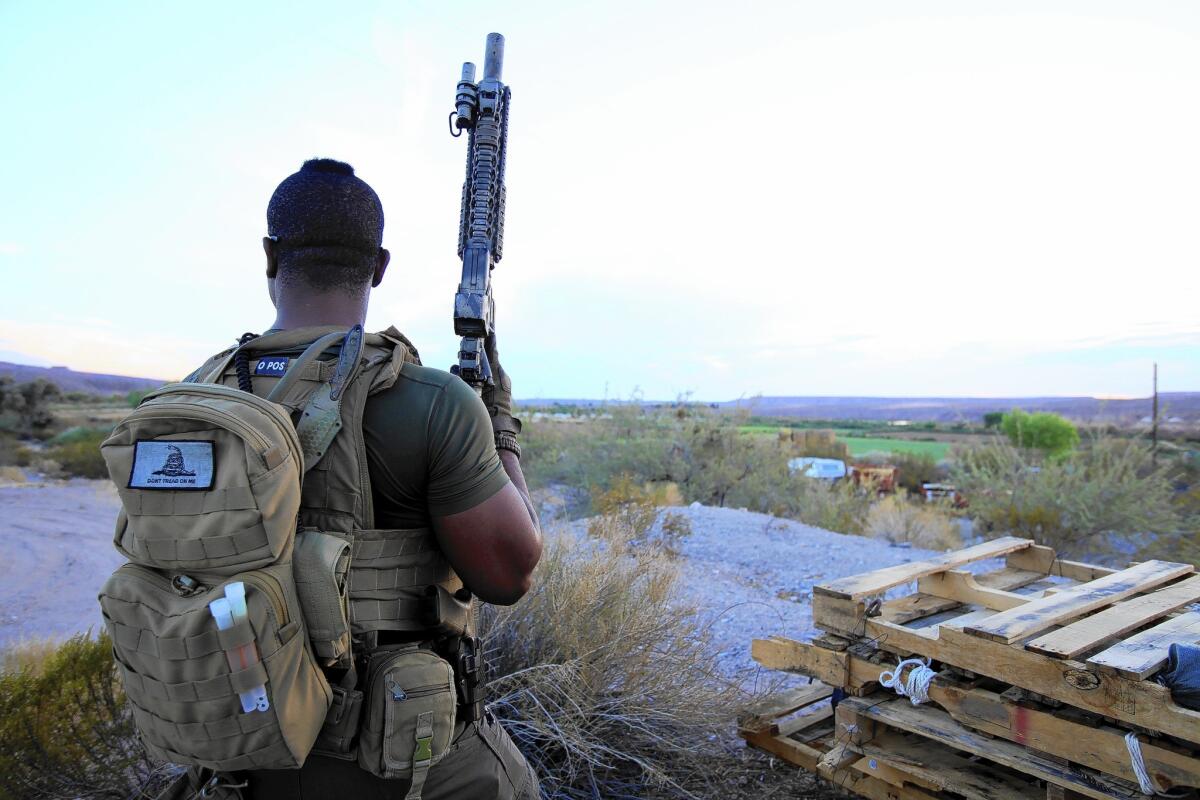BLM, local law enforcement tensions near breaking point in the West

Reporting from LAS VEGAS — James Perkins sees the federal Bureau of Land Management more as a belligerent occupying army than a government agency serving U.S. citizens, including those like him in south-central Utah.
Perkins is the sheriff of Garfield County, a rural bastion the size of Connecticut with only 5,500 residents, where 90% of the land is maintained by the BLM. The relationship between local law enforcement and often heavily armed federal officers has always been tense, and now threatens to reach a breaking point.
He and others attribute the deteriorating relations to what he calls BLM’s culture of elitism, which provoked Garfield County to join two other Utah counties this year to pass a resolution restricting or banning federal law enforcement within their borders.
“I don’t know any sheriff who doesn’t want a good relationship with the BLM,” he said. “We’re a rural agency and we’d like a partnership, but it seems they have a hard time recognizing our authority. They’d rather be independent.”
The BLM has faced a string of challenges. In April, it called off a cattle roundup after rebellious Nevada rancher Cliven Bundy was backed by an armed citizen militia that stood its ground with semiautomatic weapons. The BLM looked, in turns, overzealous and ineffectual.
Then, in May, citizens of rural San Juan County in Utah staged a protest, driving all-terrain vehicles into a canyon the BLM had closed to such traffic.
BLM officials say they’re trying to manage a mammoth swath of the West as best they can while seeking common ground with local authorities. In some of those states, though, BLM workers have felt so threatened that they patrol in unmarked vehicles, without uniforms.
Perkins and others recently addressed a House public lands subcommittee that was collecting testimony about concerns over the BLM, including claims about bullying ranchers and refusing to respond to emergency calls.
They didn’t mince words.
“Over the past decade or so we have observed and experienced a militarization of BLM’s officers,” said Leland Pollack, a Garfield County commissioner. “Right or wrong, some equate BLM’s law enforcement operations to the Gestapo of the World War II era.”
BLM officials in Washington call the claims “vague and inaccurate.”
“The agency is not elitist,” said Bob Abbey, who led the BLM from 2009 until 2012. “Everything the BLM does is based on public input or a direction from the courts, so it’s frustrating to hear criticism like this. The way I see it, we have much more in common with local law enforcement than differences, but we’ve allowed those differences to block pursuing common goals.”
Perkins testified that he has a good working relationship with other federal agencies such as the FBI and National Park Service, but not the BLM. In recent months, he said, the BLM has refused to renew law enforcement contracts with several Utah counties, citing legal deficiencies.
In an interview, he described an incident this year in which a county detective was investigating whether a BLM officer had failed to report a traffic accident, as required by law.
“I was told by the chief of BLM law enforcement in Utah that we had no right to investigate one of his officers and that the matter should have been turned over to their internal affairs division,” Perkins said. “When I’m told by the federal government that I don’t have the authority to investigate crimes in my county, well, that’s just troublesome to me.”
He said his county, which includes most of Bryce Canyon National Park and parts of Canyonlands, Capitol Reef and Grand Staircase-Escalante National Monument, has spent more than $70,000 this year assisting federal officials with search-and-rescue operations. “Yet we’ve not seen one penny from them,” he said. “There have been times when we can’t even get them to come out and assist us.”
Rep. Chris Stewart (R-Utah) told the House subcommittee that televised images of the BLM’s tense, heavily armed standoff with Bundy “looked like they were taken in Afghanistan or Iraq rather than the American West.”
In an interview, Stewart said the incident could have been avoided if federal officials had allowed the sheriff to take charge.
“They’re just more morally justified to intervene — these local sheriffs know people in the community and are more aware of what’s going on with them,” he said. “They’re also going to be held accountable more than federal agents who don’t live in the community and don’t have to answer to the people there.”
Stewart, who has concerns about the weapons carried by many federal officers, has sponsored a bill to demilitarize federal regulatory agencies.
“Nobody is trying to take away weapons from BLM law enforcement people, but some of these regulatory agencies have SWAT teams or what they call special-event tactical units,” Stewart said. “When I asked when these agencies deploy their units, I was told they couldn’t answer that. This isn’t the CIA or FBI. Why can’t they tell the American people their rules of engagement?”
Abbey said the BLM can do its part to bridge the divide with sheriffs.
“I’ve always said that it’s important for BLM people to get out into the field,” he said. “You can’t do your job by sitting behind a desk and wait[ing] for someone to come in with a complaint. There is a real need for better local relationships.”
But Perkins isn’t sure whether the wounds can be healed.
“We just have to respect each other,” he said. “These people can’t just come in and think they’re going to walk over local authorities. That doesn’t do anybody any good.”
More to Read
Sign up for Essential California
The most important California stories and recommendations in your inbox every morning.
You may occasionally receive promotional content from the Los Angeles Times.











